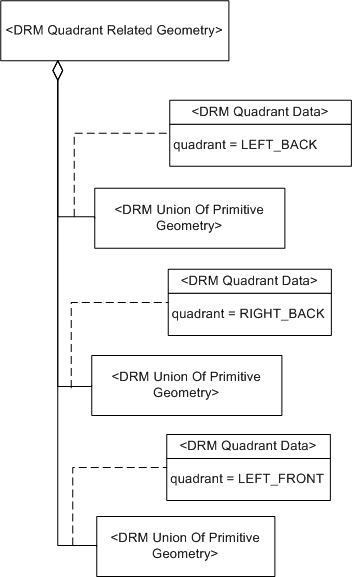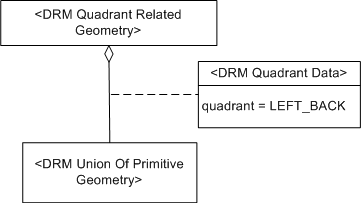Class Name: Quadrant Related Geometry
Subclasses
This DRM class is concrete and has no subclasses.
Definition
An instance of this DRM class specifies an aggregation of
<Geometry Hierarchy> components in which each
<Geometry Hierarchy> component represents a branch
of a quadrant. The quadrant represented by a branch is
specified by the <Quadrant Data> link object
associated with that branch. The bounding region that the
<Geometry Hierarchy> components occupy is
defined by the <Spatial Extent> component of the
<Quadrant Related Geometry> instance.
Primary Page in DRM Diagram:
Secondary Pages in DRM Diagram:
This class appears on only one page of the DRM class diagram.
Example
Consider a representation of a region of terrain that is organized into
quadrants, where the SE_QUADRANT_RIGHT_FRONT
quadrant consists of ocean, and the
other three quadrants consist of the terrain bordering the ocean. The
ocean quadrant is not represented in the producer's system. The region
is represented in the DRM by a <Quadrant Related Geometry>
instance with three <Union Of Primitive Geometry>
instances as depicted in Figure 51.
(Since the remaining quadrant had no
<Polygon> instances, it was not represented.)

Figure 51 — <DRM Quadrant Related Geometry> ocean example
Consider a set of environmental data that is represented in a transmittal by
a <Quadrant Related Geometry>
instance. The
SE_QUADRANT_LEFT_BACK
quadrant of the environmental data is a
<Union Of Primitive Geometry> instance
aggregated by the
<Quadrant Related Geometry> instance
as depicted in Figure 52:

Figure 52 — <DRM Quadrant Related Geometry> example
FAQs
-
If a
<Quadrant Related Geometry> instance
has less than four components, why is the data being represented using a
<Quadrant Related Geometry> instance
at all?
A
<Quadrant Related Geometry> instance
is used when the environmental data to be represented logically lends
itself to a quadrant related organization. However, since a given quadrant
within such an organization might not contain
<Primitive Geometry> instances, a
<Quadrant Related Geometry> instance
can have fewer than four components.
-
Where is the <Spatial Extent> component?
A
<Quadrant Related Geometry> instance
automatically has a <Spatial Extent> component,
because it is a
<Geometry Hierarchy> instance.
Constraints
Associated to (one-way) (inherited)
Associated by (one-way) (inherited)
Composed of (two-way) (inherited)
Composed of (two-way)
Composed of (two-way metadata) (inherited)
Component of (two-way) (inherited)
- zero or more <Alternate Hierarchy Related Geometry> instances, each through the use of a <Hierarchy Data> link object
- zero or more <Animation Related Geometry> instances
- zero or more <Classification Related Geometry> instances, each through the use of a <Classification Data> link object
- zero or one <Environment Root> instance
- zero or one <Geometry Model> instance
- zero or more <LOD Related Geometry> instances, each through the use of a <Base LOD Data> link object
- zero or more <Octant Related Geometry> instances, each through the use of an <Octant Data> link object
- zero or more <Perimeter Related Geometry> instances, each through the use of a <Perimeter Data> link object
- zero or more <Quadrant Related Geometry> instances, each through the use of a <Quadrant Data> link object
- zero or more <Separating Plane Relations> instances, each through the use of a <Separating Plane Data> link object
- zero or more <Spatial Index Related Geometry> instances, each through the use of a <Spatial Index Data> link object
- zero or more <State Related Geometry> instances, each through the use of a <State Data> link object
- zero or more <Time Related Geometry> instances, each through the use of a <Time Constraints Data> link object
- zero or more <Union Of Geometry Hierarchy> instances
Notes
Associated to Notes
An association between a
<Feature Representation>
instance and a
<Geometry Hierarchy> instance
indicates that the environmental object(s) that they
represent have the semantic relationship indicated by
the <Base Association Data>
link object on the association relationship.
An association between two
<Geometry Hierarchy> instances
indicates that the environmental object(s) that they
represent have the semantic relationship indicated by
the <Base Association Data>
link object on the association relationship.
Associated from Notes
An association between a
<Feature Representation>
instance and a
<Geometry Hierarchy> instance
indicates that the environmental object(s) that they
represent have the semantic relationship indicated by
the <Base Association Data>
link object on the association relationship.
An association between two
<Geometry Hierarchy> instances
indicates that the environmental object(s) that they
represent have the semantic relationship indicated by
the <Base Association Data>
link object on the association relationship.
An association from a
<Hierarchy Summary Item>
instance to a <Geometry Hierarchy>
instance indicates that the
<Hierarchy Summary Item> instance
summarizes that <Geometry Hierarchy>
instance.
An association from a
<Reference Surface> instance to a
<Geometry Hierarchy> instance indicates
that the <Geometry Hierarchy>
instance organizes the geometric objects that specify
the reference surface geometry of the
<Reference Surface> instance.
Composed of Notes
In the case where multiple
<Collision Volume> components are
specified for the
<Aggregate Geometry> instance,
the union
of the volumes thus specified is used in collision detection.
An <Aggregate Geometry> instance can have
an <LSR Transformation> component only when the
<Aggregate Geometry> instance is within
the scope of an LSR 3D SRF.
Fields Notes
If the value of the
unique_descendants
field is SE_TRUE, each
descendant of this aggregation, that is, each
<Geometry Representation>
instance that exists in the component tree
rooted at the <Aggregate Geometry>
instance shall be unique, in the
sense that it shall appear in only one branch
of this aggregation.
If unique_descendants
is SE_FALSE, at least one
<Geometry Representation> instance
appears in more than one branch of the aggregation.
If the value of the
strict_organizing_principle
field is SE_TRUE, each
branch of this aggregation
strictly complies with the organizing principle for its
particular subclass. If this value is
SE_FALSE, at least
one branch does not strictly comply with the given
organizing principle. See the organizing principle constraint
for each specific subclass for details.
Prev: Quadrant Related Features.
Next: Reference Origin.
Up:Index.

